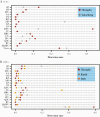Incidence, Etiology, and Environmental Risk Factors of Community-Acquired Pneumonia Requiring Hospitalization in China: A 3-Year, Prospective, Age-Stratified, Multicenter Case-Control Study
- PMID: 35548172
- PMCID: PMC8522381
- DOI: 10.1093/ofid/ofab499
Incidence, Etiology, and Environmental Risk Factors of Community-Acquired Pneumonia Requiring Hospitalization in China: A 3-Year, Prospective, Age-Stratified, Multicenter Case-Control Study
Abstract
Background: Community-acquired pneumonia (CAP) is a leading infectious cause of hospitalization and death worldwide. Knowledge about the incidence and etiology of CAP in China is fragmented.
Methods: A multicenter study performed at 4 hospitals in 4 regions in China and clinical samples from CAP patients were collected and used for pathogen identification from July 2016 to June 2019.
Results: A total of 1674 patients were enrolled and the average annual incidence of hospitalized CAP was 18.7 (95% confidence interval, 18.5-19.0) cases per 10000 people. The most common viral and bacterial agents found in patients were respiratory syncytial virus (19.2%) and Streptococcus pneumoniae (9.3%). The coinfections percentage was 13.8%. Pathogen distribution displayed variations within age groups as well as seasonal and regional differences. The severe acute respiratory syndrome coronavirus 2 was not detected. Respiratory virus detection was significantly positively correlated with air pollutants (including particulate matter ≤2.5 µm, particulate matter ≤10 µm, nitrogen dioxide, and sulfur dioxide) and significantly negatively correlated with ambient temperature and ozone content; bacteria detection was opposite.
Conclusions: The hospitalized CAP incidence in China was higher than previously known. CAP etiology showed that differences in age, seasons, regions, and respiratory viruses were detected at a higher rate than bacterial infection overall. Air pollutants and temperature have an influence on the detection of pathogens.
Keywords: bacterial pneumonia; community-acquired pneumonia; environmental factor; etiology; respiratory tract infection; viral pneumonia.
© The Author(s) 2021. Published by Oxford University Press on behalf of Infectious Diseases Society of America.
Figures





Similar articles
-
Identification of priority pathogens for aetiological diagnosis in adults with community-acquired pneumonia in China: a multicentre prospective study.BMC Infect Dis. 2023 Apr 14;23(1):231. doi: 10.1186/s12879-023-08166-3. BMC Infect Dis. 2023. PMID: 37059987 Free PMC article.
-
Effects of short-term exposure to air pollution on hospital admissions of young children for acute lower respiratory infections in Ho Chi Minh City, Vietnam.Res Rep Health Eff Inst. 2012 Jun;(169):5-72; discussion 73-83. Res Rep Health Eff Inst. 2012. PMID: 22849236
-
Etiology of community-acquired pneumonia in 1500 hospitalized children.J Med Virol. 2018 Mar;90(3):421-428. doi: 10.1002/jmv.24963. Epub 2017 Nov 9. J Med Virol. 2018. PMID: 28975629 Free PMC article.
-
Annual and seasonal patterns in etiologies of pediatric community-acquired pneumonia due to respiratory viruses and Mycoplasma pneumoniae requiring hospitalization in South Korea.BMC Infect Dis. 2020 Feb 12;20(1):132. doi: 10.1186/s12879-020-4810-9. BMC Infect Dis. 2020. PMID: 32050912 Free PMC article.
-
Etiology of community-acquired pneumonia in adults: a systematic review.Pneumonia (Nathan). 2020 Oct 5;12:11. doi: 10.1186/s41479-020-00074-3. eCollection 2020. Pneumonia (Nathan). 2020. PMID: 33024653 Free PMC article. Review.
Cited by
-
Risk factors analysis and prediction model construction for severe pneumonia in older adult patients.Front Public Health. 2024 Jun 3;12:1399470. doi: 10.3389/fpubh.2024.1399470. eCollection 2024. Front Public Health. 2024. PMID: 38887257 Free PMC article.
-
Efficacy and metabolomic analysis of the pneumonia compound formulation against community-acquired pneumonia: an observational controlled before-after clinical trial.BMC Infect Dis. 2025 Mar 31;25(1):441. doi: 10.1186/s12879-025-10823-8. BMC Infect Dis. 2025. PMID: 40165069 Free PMC article. Clinical Trial.
-
Community-acquired pneumonia caused by Micrococcus antarcticus: a rare case report.BMC Infect Dis. 2024 Oct 24;24(1):1200. doi: 10.1186/s12879-024-10084-x. BMC Infect Dis. 2024. PMID: 39449134 Free PMC article.
-
Nasopharyngeal aspirates in children with severe community-acquired pneumonia collected within 3 days before bronchoscopy can partially reflect the pathogens in bronchoalveolar lavage fluids.BMC Infect Dis. 2022 Nov 1;22(1):814. doi: 10.1186/s12879-022-07749-w. BMC Infect Dis. 2022. PMID: 36319953 Free PMC article.
-
Global Epidemiology and Seasonality of Human Seasonal Coronaviruses: A Systematic Review.Open Forum Infect Dis. 2024 Jul 18;11(8):ofae418. doi: 10.1093/ofid/ofae418. eCollection 2024 Aug. Open Forum Infect Dis. 2024. PMID: 39113828 Free PMC article.
References
-
- Gutiérrez F, Masiá M, Mirete C, et al. . The influence of age and gender on the population-based incidence of community-acquired pneumonia caused by different microbial pathogens. J Infect 2006; 53:166–74. - PubMed
-
- Murray CJL, Barber RM, Foreman KJ, et al. . GBD 2013 DALYs and HALE Collaborators. Global, regional, and national disability-adjusted life years (DALYs) for 306 diseases and injuries and healthy life expectancy (HALE) for 188 countries, 1990-2013: quantifying the epidemiological transition. Lancet 2015; 386:2145–91. - PMC - PubMed
-
- Arnold FW, Wiemken TL, Peyrani P, et al. . CAPO authors. Mortality differences among hospitalized patients with community-acquired pneumonia in three world regions: results from the Community-Acquired Pneumonia Organization (CAPO) International Cohort Study. Respir Med 2013; 107:1101–11. - PubMed
LinkOut - more resources
Full Text Sources
Miscellaneous

